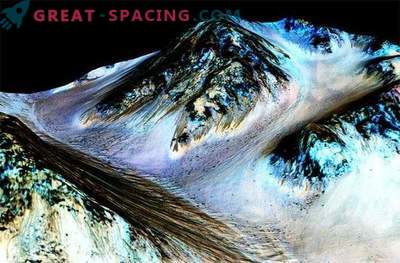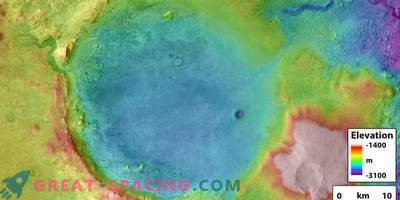
The opening of seasonal streams of water on Mars can not only mean the presence on the Red Planet of unreasonable life forms, but also breathe life into projects for the colonization of Mars. However, do not rush to pack travel bags.
The Mars Reconnaissance Orbiter automatic interplanetary station launched by NASA, which transmitted sensational images of water streams on Mars, will continue to take pictures of the planet in high resolution. It also continues not only to photograph, but also to collect information on the chemical composition of the surface and atmosphere in those places where periodic inclined lines have been found, along which seasonal streams of salt water allegedly sweep.
These lines intersect steep mountain walls near the equator, preventing them from reaching the territories where the Curiosity and Opportunity rovers operate. Even the range of another Mars-class rover Curiosity, which is scheduled to launch in 2020, is on the sidelines.
Curiosity was able to overcome several steep slopes, but the lines of the supposed current of water are beyond its reach. For an astronaut in a spacesuit to go there would be quite a simple task, but for the rover it is impracticable, and we have very few opportunities to explore these places, ”said NASA Deputy Administrator for Science John Gransfeld. “I think the discovery will encourage the inventiveness of our scientists and engineers to set up an experiment to identify life (I hope that we can do this in the 2020s) so that we can get to these areas and sometime deliver samples from there vital activity, ”he added.
The existence of water on Mars also means that future automatic stations from the Earth must be thoroughly sterilized in order to avoid microorganisms from the Earth from entering the planet. Their vital activity can be murderous and incompatible with the vital activity of living beings, possibly living on Mars.
“We try to be very careful and do not send spacecraft to Mars that could damage Mars, and we don’t want to know that we once brought life to this planet that we brought with us,” said Greenfeld.
Curiosity, which found traces of the fact that ancient Mars had the necessary ingredients and environmental conditions for the existence of microbes, can also contribute to the confirmation of the hypothesis of the existence of water. Scientists have noticed traces of sloping lines on the walls of Mount Sharp, an elevation three miles high, rising from the foot of Gale Crater, which Curiosity has been exploring since August 2012. “We don’t know for sure if Curiosity will be able to research and measure them,” said Jim Green, who heads NASA’s exploration of the planets. “Maybe these are traces of the flow of water, but maybe not. To find out, you need to do a lot of work. After three years of working on Mars, Curiosity must be sufficiently sterile to explore these areas. The question is whether his tools and equipment are suitable for this, ”Green added.
Scientists would like more information on where and when lines formed. To do this, it is necessary to conduct observations not only at 3 o'clock in the afternoon according to the Martian time, but also in the cooler morning hours. “Until we can land there. Maybe it will be possible to find more accessible places for research than these steep slopes. Perhaps there are more flat areas somewhere, ”said Alfred McEwen, a planet explorer at the University of Arizona.











































